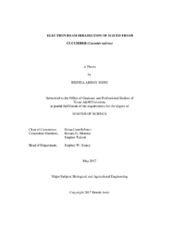| dc.description.abstract | A healthy and balance diet includes consumption of fresh fruits and vegetables. Cucumber (Cucumis sativus) is one of the most cultivated vegetable in the world and is mostly consumed raw. Raw products are recognized as important vehicles for the transmission of human pathogens which causes foodborne illness. According to the Center of Disease Control and Prevention (CDC) Foodborne Outbreak Online Database, there were nine outbreaks due to Salmonella Poona associated with consumption of contaminated food between 1998 and 2008. From July 2015 until February 2016, multistate Salmonella Poona outbreak in the USA was reported due to the consumption of contaminated and imported Californian cucumbers. Hence, measures to decontaminate fresh produce are necessary. Electron-beam irradiation is an effective nonthermal method of decontamination against pathogens such as Salmonella Poona. However, irradiation of fresh produce such as cucumbers could produce negative quality effects such as loss of texture, flavor, and nutrients.
Therefore, the process must be characterized. The main objective of this study was to (1) determine the radiation D10-value of Salmonella Poona on sliced cucumber; (2) quantify the effect of electron-beam irradiation on the product quality attributes (texture and color) throughout storage at refrigeration temperature (4-5°C); and (3) optimize irradiation treatment of sliced cucumbers to ensure proper decontamination (5D) while maintaining produce quality.
Five (± 2) grams of fresh cucumber was inoculated with 0.5 ml of a 10^8 CFU/mL of the bacterial culture of Salmonella Poona in sterile bags (18-oz). Samples were irradiated at room temperature with up to 1 kGy with an increment of 0.2 kGy using a low energy electron beam to find the D10-value of the pathogens. Samples were also be irradiated at a 5D dose for decontamination of the pathogen. Irradiated samples were stored at 4-5°C and analyzed for product quality in terms of texture, color, water activity, moisture content, pH, and sensory characteristics for 3 days. All tests were performed in three replications. Non-irradiated samples served as controls.
The D10-value of the Salmonella Poona strain used in this study was found 0.38 ± 0.03 kGy. Firmness (texture) of irradiated samples was significantly (P < 0.05) lower than the group of control samples. There was no negative effect (P > 0.05) in the other quality parameters of sliced cucumbers. Therefore, application of an e-beam irradiation decontamination step can significantly improve the microbiological safety of fresh sliced cucumbers. | en |


